Have organizations become more collaborative over 25 years? What has enabled that?
Paul Hobcraft
MAY 9, 2024
From linear to agile: Idea generation is now a continuous process, not a one-time event. Organizations are using agile methodologies to rapidly test and iterate on ideas, keeping up with the pace of change and market demands. This openness is driving innovation by bringing in fresh perspectives and new ways of thinking.



























Let's personalize your content